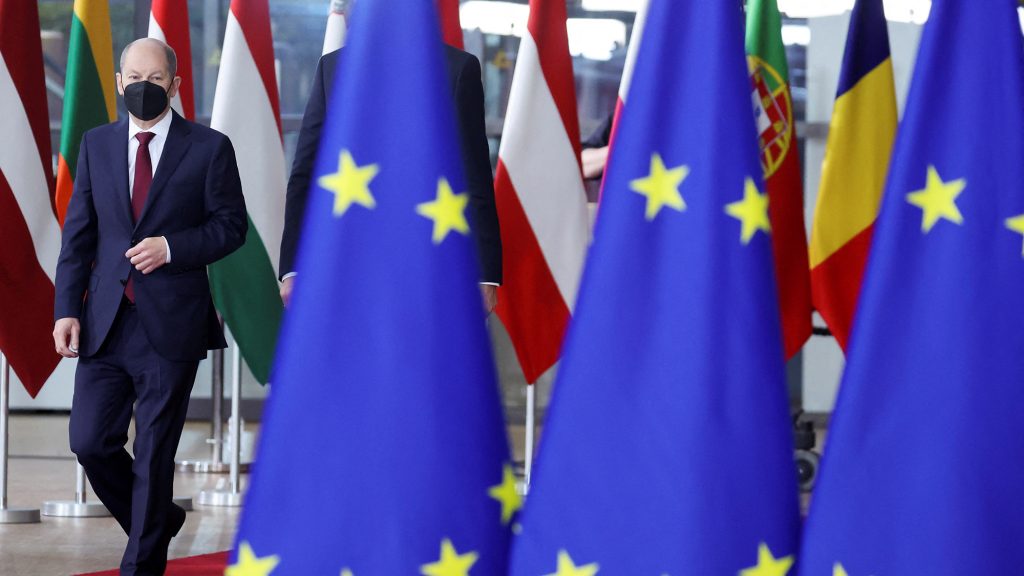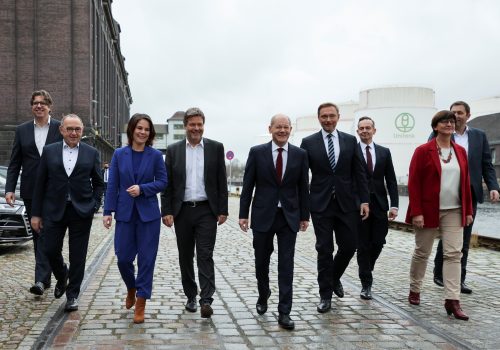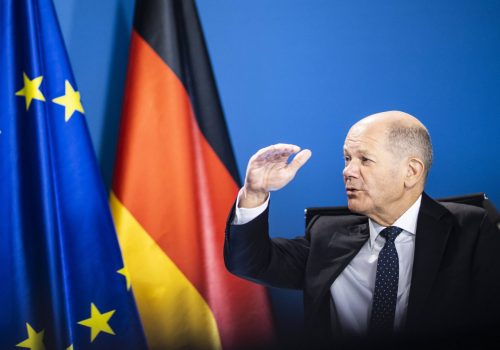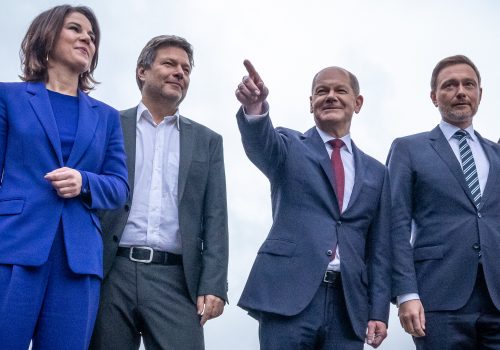This post was updated on December 17, 2021.
With a new ruling coalition in Germany, some experts are debating whether the ambitious foreign-policy goals it outlined in November suggest a major reset for the country’s international strategy, with implications for the European Union’s (EU) own external policy. Supporters of increased European military integration—especially of autonomous EU military capacity—have taken the new coalition’s interest in an assertive foreign policy, particularly against Russian aggression in Ukraine, as a sign that an EU-run military power may one day be feasible.
But while various idealistic coalition members endorsed the idea of an “European Army” in their campaigns, supporters should temper their hopes for its establishment. The parties that compose this new coalition all scrupulously avoided mentioning in their coalition pact this sensitive notion of a European Army, which evokes images of loss of national sovereignty and is more often used by Euroskeptics than not. Instead, they’re opting to work toward “European sovereignty.” But this will still require undergoing European military integration that today continues to contend with enduring political, logistical, and funding issues.
History also suggests the endeavor could be a difficult one, as there have been History also suggests the endeavor could be a difficult one, as there have been numerous failed attempts at forming autonomous EU military capacity. The United States once even fought such efforts: For example, when then UK Prime Minister Tony Blair and French President Jacques Chirac signed an agreement in 1998 at Saint-Malo to form a European military force, the Clinton administration argued that it would render NATO “a relic of the past.” US opposition to integration remained for nearly the next two decades: In 2018, the Trump administration denounced plans for an EU army. Moreover, resistance to creating an EU army remains in Central and Eastern European countries such as Poland and Latvia, as these newer NATO and EU member states feared that any EU military structures could replace existing NATO institutions and reduce US military presence in the region.
It’s likely that this history of failed attempts pushed French President Emmanuel Macron and then German Chancellor Angela Merkel to avoid making specific promises when proclaiming their support for a theoretical future EU military capacity in 2018. Even the 2019 French-German Aachen Treaty, which Merkel hailed as a step towards the EU army, did not include any explicit steps towards forming an EU army. Today, the party leaders of Germany’s new “traffic light coalition” are aware of this history and may have consequently tempered their rhetoric on military integration during coalition negotiations.
With its commitments to strengthen European sovereignty, the new German government may successfully boost international support for existing European military-integration programs. These initiatives include the EU Permanent Structured Cooperation (PESCO) program, which is meant to better coordinate military-equipment procurement across the EU and integrate military supply chains, and NATO’s Framework Nations Concept. But these are not intended to directly contribute to forming an EU army, and no military-integration initiative exists with the explicit long-term goal of forming an EU military.
Nor has their implementation been easy. PESCO especially has faced serious and repeated delays caused by hurdles such as the pandemic. Furthermore, PESCO projects depend on funds from multiple sources including the European Defense Fund (EDF), which launched in July, the EU, and national sources; but by July, twenty PESCO projects had still not received any funding from national sources. Meanwhile, the EDF also funds the development of common military equipment for EU members’ militaries—but the benefits of that funding would only come several years later, given how long it takes to improve the production of military equipment. Larger-scale military integration would need to address these deep logistical flaws that smaller programs like PESCO already face.
Despite such setbacks, some European interest in military integration remains—even in the form of smaller goals to strengthen European sovereignty—because of the United States’ wavering commitment to Europe. The German coalition agreement’s emphasis on European sovereignty follows the US withdrawal from Afghanistan and the formation of the AUKUS defense pact between the United States, United Kingdom, and Australia. While US President Joe Biden maintains a more conciliatory stance toward the European Union compared to his predecessor, recent events have cooled European hopes for a renewed US commitment to the region and incentivized more support for European sovereignty.
A partial acceleration in European military integration could also help the German coalition government deliver on its European-sovereignty ambitions. According to the European Foreign Affairs Review, PESCO has had some success in “de-fragmenting the defense market in the European Union.” Furthermore, the Biden administration has signaled its support for a PESCO project, in a move that suggests it is not as inherently opposed to integrated European armed forces as preceding US administrations. PESCO has been further reinforced by the European Intervention Initiative, a group that in practice hosts expert-level workshops to improve integrating Europe’s “strategic culture” without being a formal EU or NATO entity. And, although PESCO’s projects are behind schedule, some of the ones underway are gaining recognition, such as Cyber Rapid Response Teams and the European Medical Command.
Other developments could boost European military integration even more. Five EU members (including one that is not a NATO member) have committed in principle to one day expanding already existing EU battle groups, or multinational military units that rapidly respond in the event of crises. The European Commission has further discussed establishing a five-thousand-troop joint intervention force by 2025.
Altogether, there does appear to be momentum that the new German government can use if it wants to follow through on its commitments to strengthen European sovereignty. While the new German coalition cracks open the door to this pursuit a bit more, the new proposals for expanded EU battle groups and the material developments in European military integration should be seen as steps towards EU military capacity—if not an EU army.
There are still significant issues to overcome. Other factors include how well EU members address the problems of funding and procurement in military integration, and whether the Biden administration continues to support its development. The future of EU military integration could also hinge on the 2022 French presidential elections: If the new German coalition government cannot work with a like-minded president such as France’s Emmanuel Macron, these plans could very well stall (or worse). If more Euroskeptic candidates such as Éric Zemmour or Marine Le Pen manage to win the presidency, any breakthrough on European military integration will be impossible.
The idea of an EU military capacity is still likely to tantalize supporters of European military sovereignty for some time to come—but the debate over its utility and feasibility will last just as long.
Francis Shin is a research assistant at the Atlantic Council’s Europe Center and a 2021 geostrategy and financial diplomacy fellow at Young Professionals in Foreign Policy.
Further reading
Tue, Nov 30, 2021
Is the new German government good news for Ukraine?
UkraineAlert By
The sun is finally setting on Germany’s Merkel era and a new coalition government is poised to take over. What will this change mean for Germany’s policies towards Russia, Ukraine and the Nord Stream 2 pipeline?
Tue, Nov 30, 2021
Nord Stream 2 will test new German government’s European solidarity
UkraineAlert By
If the new German government does not block Vladimir Putin's Nord Stream 2 pipeline weapon, Ukraine will be irreversibly weakened while Germany and Europe as a whole will be sleepwalking into a perpetual gas crunch.
Wed, Nov 24, 2021
FAST THINKING: Germany finally gets a (colorful) new government
Fast Thinking By
Nearly two months after they handed a narrow victory to the Social Democratic Party (SPD)‚ German voters finally have their next chancellor.
Image: German Chancellor Olaf Scholz arrives for a European Union Summit at the European Council building in Brussels, Belgium, on December 16, 2021. Photo via Kenzo Tribouillard via REUTERS.



